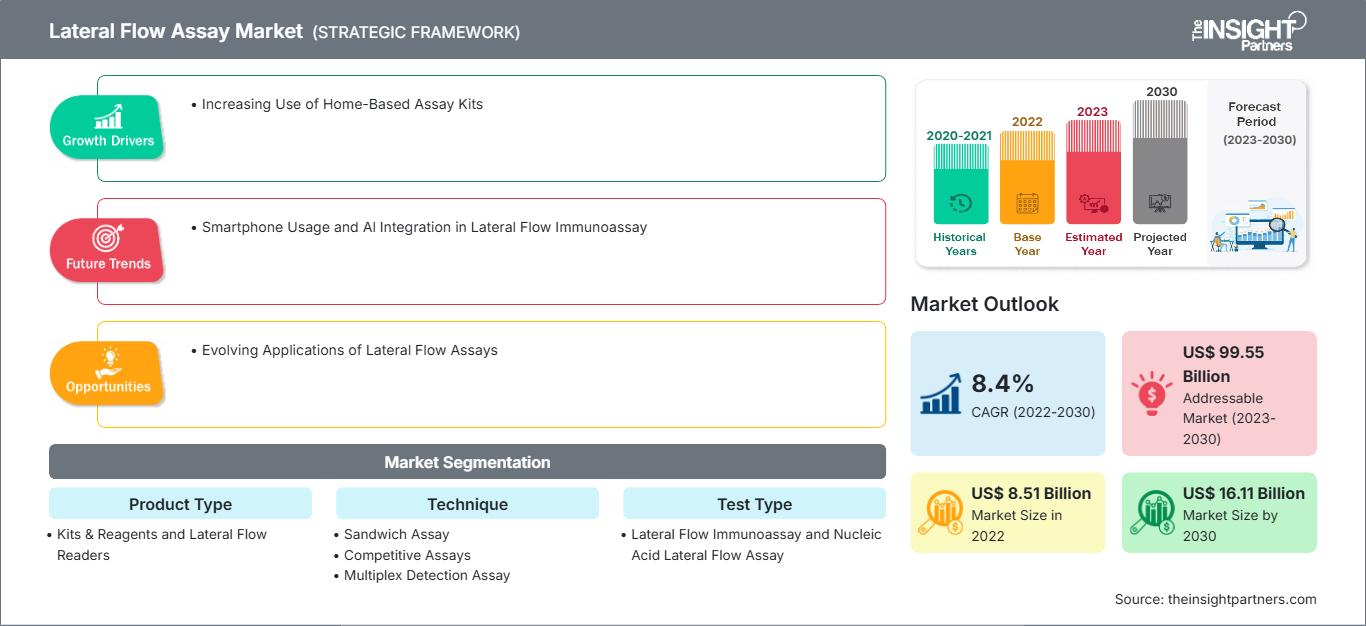[研究报告] 2022年,横向流动分析市场规模为85.0589亿美元,预计到2030年将达到161.0613亿美元;预计2022年至2030年的复合年增长率为8.4%。
市场洞察与分析师观点:
横向流动免疫分析,也称为免疫层析分析或试纸条检测,是一种易于使用的诊断工具,用于确定目标分析物(例如人类或动物体内的病原体或生物标志物)是否存在。由于横向流动分析易于使用、经济高效且可检测样本中的多种标志物,因此在治疗药物监测中越来越受欢迎。此外,传染病的日益流行和主要市场参与者的投资不断增加,推动了侧流检测市场的增长。此外,由于对侧流检测试剂盒、家用和即时检测 (POC) 的需求不断增长,各种诊断测试的普及也推动了市场的增长。
增长动力:
侧流检测 (LFA) 是一种纸质测试,用于检测复杂混合物(生物样本)中的分析物(特定条件下的生物分子),其中样本被放置在测试设备中的指定位置。这些测试可在 5 至 30 分钟内提供结果。侧流检测试剂盒在各种环境条件下均表现出稳定性,并且保质期较长。基于侧流检测的家用测试允许用户测试自行采集的样本并获得结果,而无需训练有素的医疗专业人员的协助。这些测试通常在柜台出售。妊娠检测试剂盒是家用侧流检测最常见的例子之一。此外,这些检测方法还用于诊断传染病、心血管疾病以及艾滋病毒等污名化疾病。因此,这些疾病的患病率不断上升,以及家庭医疗保健中横向流动检测法的日益普及,推动了横向流动检测法市场的增长。在 COVID-19 疫情期间,由于人们不愿去医院或诊断实验室进行检测,许多公司引入了家用横向流动检测法来诊断 SARS-CoV-2 感染。
- 2020 年 10 月,西门子医疗推出了 CLINITEST 快速 COVID-19 抗原自检,可在 15 分钟内检测出感染,以便尽早隔离感染者,避免 COVID-19 的传播。
- 2020 年 7 月,BD 推出了一种便携式快速即时抗原检测,可在 15 分钟内检测出 SARS-CoV-2 感染。
- 2020 年 8 月,美国食品药品监督管理局 (FDA) 为雅培 BinaxNOW COVID-19 Ag Card 颁发了紧急使用授权,这是一种用于检测 SARS-CoV-2 的快速检测方法。 BinaxNOW 采用雅培成熟的横向流动技术,使其成为医疗服务提供者进行频繁大规模检测的友好可靠方法。
- 2020 年 9 月,罗氏公司面向接受 CE 标志的市场推出了 SARS-CoV-2 快速抗原检测。
自定义此报告以满足您的要求
您将免费获得任何报告的定制,包括本报告的部分内容,或国家级分析、Excel 数据包,以及为初创企业和大学提供超值优惠和折扣
横向流动分析市场: 战略洞察

-
获取本报告的主要市场趋势。这个免费样本将包括数据分析,从市场趋势到估计和预测。
报告细分和范围:
横向流动分析市场根据产品类型、技术、测试类型、应用、最终用户和地域进行分类。根据产品类型,横向流动分析市场分为试剂盒和试剂以及横向流动读取器。根据技术,横向流动分析市场分为夹心分析、竞争性分析和多重检测分析。根据测试类型,横向流动分析市场分为横向流动免疫分析和核酸横向流动分析。根据应用,横向流动分析市场分为临床测试、兽医诊断、食品安全和环境测试以及药物开发和质量测试。根据最终用户,横向流动分析市场分为医院和诊所、诊断实验室、家庭护理、兽医诊所、制药和生物技术公司等。横向流动分析市场按地域划分,可分为北美(美国、加拿大和墨西哥)、欧洲(法国、德国、英国、西班牙、意大利、比荷卢三国和欧洲其他地区)、亚太地区(中国、印度、日本、澳大利亚、韩国和亚太地区其他地区)、中东和非洲(沙特阿拉伯、阿联酋、南非、科威特、阿曼、卡塔尔、埃及和中东和非洲其他地区)以及南美洲和中美洲(巴西、阿根廷和南美洲和中美洲其他地区)。
分段分析:
按产品类型,横向流动分析市场可分为试剂盒和试剂以及横向流动读取器。试剂盒和试剂细分市场在 2022 年占据了更大的市场份额,预计在 2022 年至 2030 年期间市场复合年增长率将更高。随着试剂盒和试剂需求的大幅增长,横向流动检测市场预计将快速增长。许多地区的人畜共患疾病和其他动物疾病发病率大幅上升。亚洲和非洲是人畜共患疾病的热点地区,这些疾病由动物传播给人类。据世界卫生组织 (WHO) 称,2012 年至 2022 年间,非洲爆发了马尔堡病毒病和几种人畜共患疾病。2012 年至 2022 年间,该地区的人畜共患疾病发病率增长了 63%,远高于前十年。此外,2001 年至 2022 年期间,人畜共患疾病约占非洲报告的传染病疫情的 32%。因此,全球对动物疾病诊断的需求日益增长。这鼓舞了赛默飞世尔科技公司 (Thermo Fisher Scientific Inc)、Bio-Rad Laboratories, Inc 等公司;和 F. Hoffmann-La Roche AG 合作,提供各种试剂和试剂盒,包括 FDA 紧急使用授权的 RT-PCR 检测试剂盒,用于样本采集、病毒核酸分离、鉴定和定量,从而实现可靠和准确的 SARS-CoV-2 检测、抗菌药物敏感性测试、狂犬病诊断测试和 qPCR。
根据技术,横向流动检测市场分为夹心检测、竞争性检测和多重检测检测。夹心检测部分在 2022 年占据了最大的市场份额。然而,多重检测检测部分预计将在 2022 年至 2030 年期间录得最高复合年增长率。
按测试类型,横向流动检测市场分为横向流动免疫测定和核酸横向流动检测。 2022 年,侧流免疫测定部分占据了更大的市场份额,预计 2022 年至 2030 年市场复合年增长率将更高。侧流免疫测定,也称为免疫色谱测定或试纸条测试,是一种易于使用的诊断工具,用于确定目标分析物(例如人类或动物中的病原体或生物标志物)是否存在。侧流免疫测定测试在减少 COVID-19 疫情的影响方面发挥了关键作用,因为它们能够快速检测出感染者并阻止 SARS-CoV-2 的进一步传播。侧流免疫测定部分在 2022 年占据了最大的市场份额。基于侧流的免疫测定法广泛用于在医院、临床实验室和诊所中定量和定性检测各种抗体和抗原。它是一种简单且经济有效的分析方法,用于筛查、监测和诊断各种疾病。因此,横向流动免疫测定法的实用性极高;任何医疗专业人员和/或患者都可以在家中使用。
就应用而言,横向流动测定法市场分为临床检测、兽医诊断、药物开发和质量检测以及食品安全和环境检测。临床检测领域在 2022 年占据最大的市场份额。然而,预计药物开发和质量检测领域在预测期内的复合年增长率最高。
根据最终用户,横向流动测定法市场分为医院和诊所、诊断实验室、家庭护理、兽医诊所、制药和生物技术公司以及其他。此外,医院和诊所领域在 2022 年占据最大的市场份额。然而,制药和预计生物技术公司部门将在预测期内录得最高的复合年增长率。
区域分析:
横向流动分析市场主要分为北美、欧洲、亚太地区、南美和中美以及中东和非洲。2022 年,北美占据了大部分市场份额。同年,美国占据了该地区最大的市场份额。北美市场增长的特点是各种疾病的患病率不断上升、政府对先进诊断技术采用的支持以及市场参与者在研发和其他活动方面加大力度。此外,诊断行业的技术进步很可能成为未来几年北美横向流动分析市场的主要驱动力。
美国卫生与公众服务部的报告指出,美国约有 30% 至 40% 的人患有幽门螺杆菌感染。同样,根据PubMed Central(2020年)发表的一项研究,加拿大的幽门螺杆菌感染率估计在20%至30%之间。为了应对美国的高感染率,各大顶级竞争企业推出了基于侧流免疫分析的创新产品,用于定性检测幽门螺杆菌抗原。例如,赛默飞世尔科技的创新产品“RAPID Hp StAR侧流试剂盒”可直接从粪便样本中检测幽门螺杆菌抗原。
此外,美国的肝炎病毒感染率很高,这推动了基于侧流分析的检测试剂盒的应用。根据2020年病毒性肝炎监测报告,美国每年有超过一万人感染肝炎。其中,急性丙型肝炎的发病率在过去十年中增加了 124%,2020 年比 2019 年增加了 15%。此外,加拿大生物技术行业的其他各种技术进步也增加了对横向流动检测法的需求。例如,2021 年 2 月,加拿大公司 Laipac Technology Inc. 与两家阿联酋公司 YAS Pharmaceuticals LLC 和 Pure Health LLC 合作,推出了首个基于人工智能 (AI) 的快速 COVID-19 抗原检测。2020 年 4 月,美国 Bio-Rad Laboratories 推出了一种基于血液的免疫分析试剂盒,用于识别 SARS-CoV-2 抗体。此外,一些公司正在加拿大分发用于检测幽门螺杆菌的检测试剂盒。例如,2021年6月,Biomerica Inc.宣布与一家加拿大合作伙伴达成一项为期五年的协议,该合作伙伴将负责分销和推广一种名为Biomerica hp+ detect的新型专有幽门螺杆菌检测产品。该检测产品旨在识别和监测幽门螺杆菌感染。幽门螺杆菌感染是十二指肠溃疡和胃溃疡的主要原因,也是与胃癌相关的风险因素。因此,上述因素支持了北美市场的增长。
行业发展和未来机遇:
全球横向流动分析市场主要参与者采取的各种举措如下:
- 2023 年 3 月,罗氏公司宣布 FDA 批准 Ventana PD-L1 (SP263) 检测,用于检测有资格接受 Libtayo(一种由 Regeneron 开发的 PD-1 抑制剂疗法)治疗的非小细胞肺癌患者。
- 2022 年 5 月,Bio-Rad Laboratories 推出了 CFX Duet 实时 PCR 系统,以支持研究人员开发单重和双重定量 PCR 检测。该系统具备公司CFX Opus系统强大的热性能和专有的精确光学穿梭系统。
- 2021年4月,Hologic以约7.95亿美元收购了芬兰-法国私营分子诊断检测和仪器开发商Mobidiag Oy。Hologic计划投资检测方法开发,以推动Novodiag平台的普及。Novodiag系统结合了实时PCR和微阵列功能。
- 2020年4月,Hologic推出了一款基于Panther系统用于检测SARS-CoV-2的新型Aptima分子检测方法。该系统完全自动化,配备高通量分子诊断平台,该平台已在60个国家/地区和美国50个州安装。它可在三小时内提供初步结果,每天可处理超过1000次COVID-19检测。
横向流动分析
横向流动分析市场区域洞察The Insight Partners 的分析师已详尽阐述了预测期内影响横向流动分析市场的区域趋势和因素。本节还讨论了北美、欧洲、亚太地区、中东和非洲以及南美和中美洲的横向流动分析市场细分和地域分布。
横向流动分析市场报告范围
| 报告属性 | 细节 |
|---|---|
| 市场规模 2022 | US$ 8.51 Billion |
| 市场规模 2030 | US$ 16.11 Billion |
| 全球复合年增长率 (2022 - 2030) | 8.4% |
| 历史数据 | 2020-2021 |
| 预测期 | 2023-2030 |
| 涵盖的领域 |
By 产品类型
|
| 覆盖地区和国家 |
北美
|
| 市场领导者和主要公司简介 |
|
横向流动分析市场参与者密度:了解其对业务动态的影响
由于消费者偏好的不断变化、技术进步以及对产品优势的认知度不断提高等因素,终端用户的需求不断增长,推动了横向流动检测市场快速增长。随着需求的增长,企业正在扩展产品线,不断创新以满足消费者需求,并抓住新兴趋势,从而进一步推动市场增长。

- 获取 横向流动分析市场 主要参与者概述
竞争格局和主要公司:
雅培实验室 (Abbott Laboratories)、罗氏公司 (F. Hoffmann-La Roche Ltd.)、赛默飞世尔科技 (Thermo Fisher Scientific Inc.)、伯乐实验室 (Bio-Rad Laboratories, Inc.)、生物梅里埃公司 (bioMerieux SA)、Quidel 公司、珀金埃尔默公司 (PerkinElmer Inc.)、豪洛捷公司 (Hologic Inc)、默克公司 (Merck KGaA)、碧迪公司 (Becton, Dickinson and Company)、西门子医疗股份公司 (Siemens Healthineers AG) 和凯杰公司 (QIAGEN) 是横向流动分析市场的领军企业。这些公司专注于推出新的高科技产品、改进现有产品并拓展市场,以满足全球日益增长的消费者需求。
- 历史分析(2 年)、基准年、预测(7 年)及复合年增长率
- PEST和SWOT分析
- 市场规模、价值/数量 - 全球、区域、国家
- 行业和竞争格局
- Excel 数据集
近期报告
相关报告
客户评价
购买理由
- 明智的决策
- 了解市场动态
- 竞争分析
- 客户洞察
- 市场预测
- 风险规避
- 战略规划
- 投资论证
- 识别新兴市场
- 优化营销策略
- 提升运营效率
- 顺应监管趋势






















 获取免费样品 - 横向流动分析市场
获取免费样品 - 横向流动分析市场